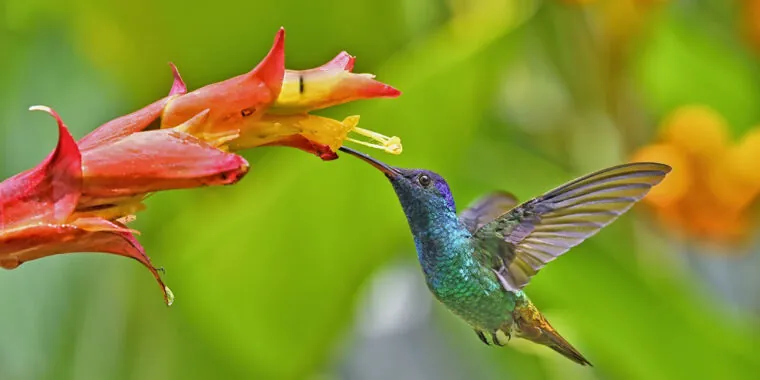
The Thrilling Survival Secrets of Hummingbirds: Nature's Tiny Powerhouses
2024-09-26
The Fascination with Hummingbirds
Hummingbirds are a mesmerizing sight for anyone lucky enough to witness their swift aerial maneuvers, darting around flowers in vibrant colors and fiercely guarding feeders as though it’s their personal treasure. However, for scientists dedicated to studying these extraordinary creatures, hummingbirds represent far more than just a colorful spectacle. Their minuscule size combined with an astounding metabolism means they live precariously, sometimes needing to almost completely shut down their bodies to conserve enough energy for survival—be it through the chilly nights or while undertaking epic migrations spanning thousands of miles, including perilous crossings over open water.
With a diet primarily consisting of nectar—their source of high-octane energy—hummingbirds maintain blood-sugar levels that would lead to dire consequences for humans. Additionally, their high-speed flight can generate g-forces that rival those experienced by fighter pilots, presenting an extraordinary physiological puzzle for researchers to unravel. The more scientists study these avian wonders, the more astonishing discoveries emerge regarding their unique adaptations.
Holly Ernest, a conservation ecologist at the University of Wyoming, points out, “They’re the only birds in the world that can fly upside down and backwards! Despite consuming pure sugar, they don’t suffer the consequences of diabetes.” This incredible resilience is one of the many captivating features that researchers are exploring as they seek to comprehend how hummingbirds meet the extreme demands of their lifestyles.
The Truth About Their Work Ethic
For decades, the prevailing assumption was that hummingbirds spent roughly 30 percent of their day energetically flitting from flower to flower to drink nectar, while the rest of the time was spent resting. However, physiological ecologist Anusha Shankar of the Tata Institute of Fundamental Research in India decided to investigate further. To understand the daily activities of broad-billed hummingbirds in Southern Arizona, she meticulously measured their metabolic rates during various tasks.
Her findings were groundbreaking. Shankar discovered that the energy expenditure and activity levels of hummingbirds can vary significantly depending on environmental factors. During the summer, when flowers are plentiful, hummingbirds could fulfill their energy needs in just a few hours of feeding and spend up to 70 percent of their day perched. However, after the onset of monsoon rains when blooms became scarce, the same birds were found to feed for up to 13 hours a day—an astonishing feat that left Shankar in awe.
The Ingenious Energy-Saving Strategy
One jaw-dropping adaptation hummingbirds employ to manage their energy reserves is the ability to enter a state known as torpor. When energy stores run low, a hummingbird can lower its body temperature to a level near that of the surrounding air, sometimes even just above freezing. In this state, they appear almost lifeless, exhibiting sluggish movements and intermittent breathing. Research indicates that this strategy can conserve an astonishing 95 percent of their hourly metabolic costs through chilly nights or periods of reduced food availability, such as after storms.
Furthermore, torpor plays a critical role as hummingbirds prepare for migrations, permitting them to fatten up before embarking on their demanding journeys. Shankar is diving deeper into the science of torpor by investigating which aspects of hummingbird physiology are prioritized during this state. “What is the critical 10 percent of your metabolism required to maintain function in torpor?” she wonders.
Final Thoughts: Nature's Marvels Unraveled
As we learn more about these unique adaptations, the question looms: How do these tiny beings manage such immense challenges with remarkable resilience? Hummingbirds are not only a spectacle of nature; they are living embodiments of survival, challenging our perceptions and leaving researchers eager for more answers. Their dynamic exists at the intersection of incredible physical feats and profound evolutionary strategies, reminding us how intricate and fascinating the natural world can be.
Stay tuned—who knows what further revelations await in the astonishing life of these tiny avian dynamo!



 Brasil (PT)
Brasil (PT)
 Canada (EN)
Canada (EN)
 Chile (ES)
Chile (ES)
 España (ES)
España (ES)
 France (FR)
France (FR)
 Hong Kong (EN)
Hong Kong (EN)
 Italia (IT)
Italia (IT)
 日本 (JA)
日本 (JA)
 Magyarország (HU)
Magyarország (HU)
 Norge (NO)
Norge (NO)
 Polska (PL)
Polska (PL)
 Schweiz (DE)
Schweiz (DE)
 Singapore (EN)
Singapore (EN)
 Sverige (SV)
Sverige (SV)
 Suomi (FI)
Suomi (FI)
 Türkiye (TR)
Türkiye (TR)